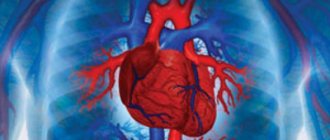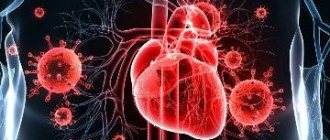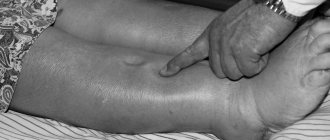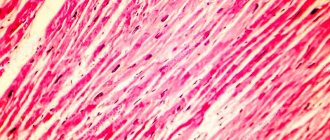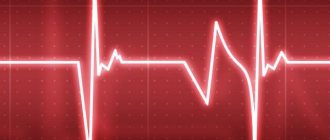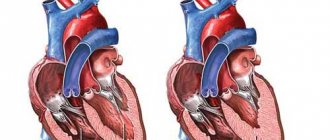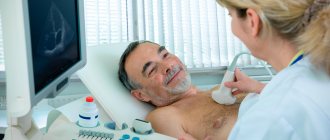People are getting older, diseases are getting younger... Previously, it was believed that heart failure was the lot of the older generation, but as life shows, this disease does not disdain young people.
Along the same path as arterial hypertension, myocardial exhaustion, ischemia and myocarditis, there is heart failure or, as it is also called, cardiac fatigue. The heart muscle loses its ability to function at full capacity and uninterruptedly pump the required volume of blood.
“Heart failure is a complex of disorders caused mainly by a decrease in the contractility of the heart muscle.” Wikipedia
In women, the heart muscle is not able to relax because it is under constant tension. People say: “The heart turns to stone.” In men, on the contrary, with each beat the heart pumps blood worse.
Not easy to recognize
Recognizing the symptoms of heart failure is not easy. Why? They manifest themselves as simple malaise, fatigue or any other problem. The first signs of cardiac fatigue:
- Fast fatiguability
- Weakness
- Weight gain
When the disease has already made itself known enough, symptoms characteristic of heart failure appear:
- Upper abdominal pain or feeling of fullness
- Edema
- Dyspnea
- Blueness of the nasolabial triangle
- Blueness of nails
At the first signs, it is enough to change your lifestyle, give up the bad habits of alcohol and smoking, and the disease can be stopped.
Most common reasons
Heart failure most often occurs with pathologies of the heart and blood vessels, such as:
- Cardiac ischemia
- Hypertension
- Valve abnormalities
- Inflammation of the heart muscle
- Cardiosclerosis
- Heart attack leading to myocardial infarction
- Damage to muscle fibers by infections caused by trypanosomes
- Diabetes
The functioning of the heart can be undermined by drinking and smoking.
Diagnosis and treatment
If your heart muscle hurts, what should you do?
To determine the causes of pain on the left side of the chest, you need to consult a specialist as soon as possible and undergo an examination. To begin with, of course, a cardiogram is performed. For any pain, it is prescribed. This research method allows you to trace the work of the heart on a graph.
A type of cardiogram is a monitoring electrocardiogram. Unlike usual, it monitors the work of the heart throughout the day. Often, a cardiologist recommends undergoing a study of heart tones and sounds, studying the functioning of muscles and valves. It is mandatory to study the speed of blood circulation using ultrasound.
To identify the likelihood of disease in other organs, patients are recommended to undergo a spinal examination using x-rays or other measures. The therapist also issues referrals for examination of the abdominal cavity, an endocrinologist and a neurologist.
A detailed survey of the patient reveals a lot of interesting facts, based on which a specialist can make a diagnosis. Anyone suffering from heart pain is recommended to keep a diary in which they should record in detail all their sensations, symptoms, nature and duration of pain. Very often, the patient passionately describes his pain and complains to the doctor about a serious pathology, but the cause turns out not to be in the heart.
Purely psychologically, people who understand that their heart really hurts talk about it sparingly. For any pain, you must trust your cardiologist, let him help you make the correct diagnosis and prescribe the necessary therapy.
It is very important to undergo treatment, and always in full. For heart problems, this may even be an operation, without which the patient’s life is in constant danger.
Emergency help or how to react?
Treatment of heart failure in the early stages requires the correct balance between physical activity, rest, nutrition and bed rest. How to react if...
Fatigue and weakness
When a person experiences weakness and fatigue, most likely the body does not have enough oxygen.
What to do?
- Spend more time outdoors
- Go out into nature
- Ventilate the room more often
- Don’t overwork yourself, give yourself extra rest during the day
Dyspnea
During physical exertion, breathing intensifies and becomes more frequent, it is difficult even to climb stairs - this is shortness of breath.
What to do?
Stop doing what caused shortness of breath. Until your breathing returns to normal, do nothing, rest. Sometimes it happens that shortness of breath can occur even at rest. In this case, you need to lie down, making the head of the bed higher. If shortness of breath begins after sleep, then you need to sit down, dangle your legs, move your feet and wiggle your fingers. You can walk around the room.
Edema
Swelling of the ankles is characteristic of heart failure. Especially in the late afternoon. They usually go away by morning. But if the disease is advanced, swelling persists constantly.
Frequent, irregular heartbeat
Do not panic if your pulse is weak or irregular. But what to do?
Take a deep breath, hold your breath and exhale slowly. Continue breathing like this until your breathing is restored.
It’s better to call an ambulance, but breathe while it’s driving. The main thing is to calm down and not be nervous. If your heart is fluttering and breathing does not help, you can press on the eyeballs, but first close your eyes.
Weight gain
With heart failure, quite often, body weight increases. Why is this happening? The reason for weight gain is fluid retention in the body.
What to do?
Eat as little salt as possible, as it can retain liquid. Under no circumstances should you consume more than 1-1.5 teaspoons of salt.
Weak heart muscle symptoms treatment
Atrophy of the heart muscle develops mainly in old people and is called physiological atrophy or involution.
Another cause of atrophy is various diseases and unfavorable factors; this form is called pathological atrophy.
There is another name for this disease, namely brown atrophy, due to the accumulation of brown pigment - lipofuscin - in the affected cells. Due to this, muscle tissue changes its natural color to brown.
Causes of development of cardiac muscle atrophy
The cause of the development of myocardial cell atrophy or myocardial dystrophy is a physiological or pathological decrease in the load on the heart muscle.
This process can involve all or several layers of muscle tissue at once and leads to a decrease in heart mass - myocarditis.
As a rule, the disease is typical for elderly people, but can also be observed in long-term diseases accompanied by depletion of the body. Senile atrophy is characterized by the addition of atrophy of other organs and systems.
As a result of improper or inadequate nutrition, the body experiences an acute shortage of proteins, carbohydrates, vitamins and various microelements, which also leads to the development of myocardial dystrophy.
In pathological processes of an infectious nature, acute food and industrial poisoning, alcohol abuse and diseases that cause metabolic disorders, tissue respiration changes, which is the main cause of pathological changes in the heart muscle.
Excessive constant physical stress is also considered an important factor in the development of myocardial atrophy, especially in young people. Due to the increased consumption of the reserve capabilities of the muscles, their rapid wear occurs.
Atrophy of the heart muscle can be a consequence of such a common disease as cardiosclerosis.
Especially in the case of a stenotic variant, when, against the background of increasing atrophy of the heart muscle, oxygen starvation of tissues and disruption of metabolic processes are noted.
As a result, instead of muscle fibers, small scars of connective tissue are formed, gradually replacing the myocardium, and normal blood flow and blood supply to the blood vessels of the heart are disrupted. Such changes lead to a weakening of the contractile function of the heart muscle and the development of heart failure.
Found an error in the text? Select it and a few more words, press Ctrl + Enter
Symptoms of the development of cardiac muscle atrophy
Atrophy of the heart muscle (myocardial dystrophy) is a non-inflammatory disease characterized by impaired metabolic processes in cells, a decrease in myocardial contractility and a decrease in the efficiency of nutrition of the heart muscle.
Due to impaired contractile function, normal blood circulation of the myocardium is disrupted. The patient begins to experience pain in the heart area, peripheral edema of a transient nature appears, disappearing after a night's rest, discomfort in the chest, fatigue, and drowsiness.
Heart failure increases gradually: the first symptoms are peripheral edema and shortness of breath during heavy physical exertion. As the disease progresses, the symptoms intensify, swelling becomes constant, and shortness of breath and palpitations are present even at rest.
Patients complain of increased cough with a large amount of sputum, especially in the evening, severe weakness, and impaired performance. The clinical picture differs in different patients due to the causes of myocardial atrophy and the presence of concomitant diseases.
If the process is compensated, then symptoms may not appear for several years. The onset and development of the disease can begin at any age.
Diagnosis of cardiac muscle atrophy
You can evaluate the work of the myocardium, detect scar formations, changes in the size and shape of the heart, and check the contractile function using cardiac ultrasound. An electrocardiogram shows changes in heart rhythm, post-infarction conditions and complications.
Treatment of cardiac muscle atrophy
If changes in the myocardium are age-related, then treatment is supportive and symptomatic.
If there is a medical history aggravated by various diseases or factors leading to the development of cardiac muscle atrophy, therapy will first be aimed at treating the underlying disease.
Symptomatic therapy is carried out to improve metabolic processes in the heart muscle. Rest, limitation of physical activity and proper, nutritious nutrition are also recommended.
At the initial stage, all these processes are reversible; with timely proper treatment, restoration of the normal structure and function of the myocardium is possible.
How to strengthen your heart muscle
5 stars - built on 71,719 views
Once upon a time, in one of the Soviet songs, the heart was compared to a fiery engine, which, in fact, is absolutely correct: just as a car with a non-working engine cannot budge, even if there is no visible damage to the body, a person, even the most beautiful, cannot live. if his engine doesn't start. And, like any engine, the heart needs constant attention, high-quality fuel and timely prevention, which must be carried out before it begins to malfunction. Therefore, it is very important to know how to strengthen the heart muscle and what weakens it.
Causes of weakening of the heart muscle
The heart muscle, when nothing threatens it, works unnoticed . But if there are signs such as pain in the chest, shortness of breath, heart palpitations stronger than usual, increased fatigue, fever, these may be symptoms of inflammation of the heart muscle, which needs help. Pain should be especially alarming at rest or after light exercise.
If the heart muscle hurts, shortness of breath and irregular heart rhythms appear after physical exertion, we can talk about dystrophy of the heart muscle, which can be expressed in various degrees of heart failure.
The heart muscle weakens due to many factors:
- heart cell nutritional disorders;
- stress;
- attacks by free radicals on myocardial cell membranes, which are enhanced by smoking or tanning;
- potassium deficiency formed due to stress and excess salt, sugar, and alcohol in the diet;
- blood thickening due to lack of water entering the body;
- inflammation of the heart muscle as a result of an allergic reaction, tonsillitis, sore throat, toxoplasmosis, influenza, scarlet fever or other infectious diseases;
- sedentary lifestyle.
Ways to strengthen the heart muscle
Strengthening the heart muscle helps prevent unwanted consequences in the form of serious diseases.
The main property of the heart muscle is to pump blood through the chambers of the heart using valves into the blood circulation system in the body.
In addition to the mechanical ones, the physiological properties of the heart muscle are known: conductivity, excitability, contractility, automaticity and refractivity, that is, the abilities:
- carry out excitation at different speeds in different parts of the myocardium;
- respond with contractions to stimuli, regardless of their strength;
- in a healthy state, contract with a force depending on the length of the muscle fibers, and in a weakened state, compensate for the lack of contraction force by increasing the rhythm;
- contract rhythmically without external stimuli only under the influence of impulses arising within itself;
- do not conduct new impulses at the moment of excitation.
The fact that the human heart muscle is characterized by automaticity has been known for a long time, but under the influence of which impulses, scientists only recently learned. The main impetus for the work of the heart is considered to be a change in the ionic permeability of the membranes of P-cells of the sinoatrial node.
To strengthen the heart muscle, it is recommended:
- conduct heart training, preferably in the fresh air (biking, swimming, race walking, climbing stairs);
- avoid the scorching sun;
- if you already have a heart disease, you need to avoid steam baths and saunas, as they increase cardiac stress;
- give up bad habits;
- establish a balanced, low-cholesterol diet;
- avoid stressful situations;
- maintain a sleep and rest schedule;
- pay close attention to your body's signals.
The diet of a person who wants to help his heart should contain potassium, magnesium, iodine and vitamins C and P. Potassium reserves can be replenished with zucchini, grapes, bananas, raisins, apricots, legumes and cocoa.
Oats, buckwheat, watermelons, nuts, seafood legumes are rich in magnesium, and cabbage, cottage cheese, beets and seafood are rich in iodine.
The necessary vitamins for the heart muscle are found in oranges, sweet peppers, apples, raspberries, strawberries and black currants.
There are many recipes for strengthening the heart muscle using folk remedies. The most delicious is a remedy made from equal parts of cheese, walnuts and raisins, which should be consumed a few teaspoons every day. If desired, cheese can be replaced with honey.
The most commonly used medications to strengthen the heart muscle are:
- asparkam,
- riboxin,
- hawthorn tincture,
- Rhodiola rosea.
Asparkam replenishes the body's supply of magnesium and potassium and improves electrolyte metabolism in the heart muscle. Riboxin enhances her nutrition and normalizes her rhythm. Hawthorn tincture strengthens the tone of the heart muscle and relieves nervous excitement, and Rhodiola rosea improves its contractility. The latter remedy should be taken little by little because of its stimulating effect.
It is better to strengthen the heart preventively, before the first bell rings, but even if you have heart disease, it is never too late to help yourself and your source of life.
how to strengthen your heart:
Source: https://DriveAuto-Ural.ru/myshtsy/slabaya-serdechnaya-myshtsa-simptomy-lechenie/
Fear of death
Usually heart failure develops gradually, but... it happens over hours and even minutes...
A “special” case appears:
- A hacking cough
- With bubbling breath
- Foamy sputum
- Increased heart rate
- Wet and cold skin
- Pressure drop
This often happens in a dream. A person wakes up from suffocation in a cold sweat and a panicky fear of death.
In this case, you should urgently call an ambulance, and provide first aid until the doctor arrives.
